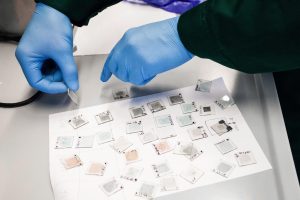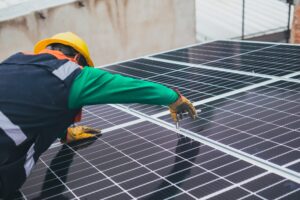The recent scientific article is Dr Magomedov’s second co-authored publication in Science and is serving as a follow-up to the previous one, proposing a solution to the challenge at hand.
“Although our materials help achieve the highest efficiency, it is difficult to form another layer on top. After our previous paper in Science, we received a lot of attention and comments about how our materials act in different contexts. In the current paper, we show one way to address the problems,” says Dr Magomedov.
More details about the improvement proposed by the KTU research team, which, together with the solutions developed by other scientists around the world, has led to the construction of an ultra-high-efficiency tandem solar cell, can be found in the scientific article. The ultra-high efficiency tandem solar cell was constructed by a research group led by Prof Steve Albrecht from Helmholtz-Zentrum Berlin, in Germany.
Silicon solar cells have a peak potential efficiency of only 29%; the world needs more and more alternative energy sources due to the climate change crisis. Tandem solar cells consist of two types of photoactive layers – a perovskite solar element is placed on top of the silicon. The silicon layer collects infrared light, while the perovskite collects blue light from the visible spectrum, increasing the efficiency of the solar cell. However, according to Dr Magomedov, it will still take time for the new generation of solar cells to replace those in use today.
“In theory, electricity made by tandem solar cells would be cheaper because the additional materials used are cheaper. However, in practice, the final commercial product does not exist, and the technological processes are not ready for mass production. Moreover, the cell itself, which is only being developed in laboratories so far, also raises unanswered questions. For example, not all materials are suitable for mass production, which means that alternatives have to be found,” explains the KTU scientist.
One of the biggest challenges in the production of these cells so far, he says, is their stability. Solar cells are expected to last for 25 years, during which time they will lose 10% of their efficiency. However, testing over such a long period of time is difficult, so there is no definitive answer as to how the new generation of solar cells will wear out.
Lithuanian chemists – world experts in new materials for solar cells




